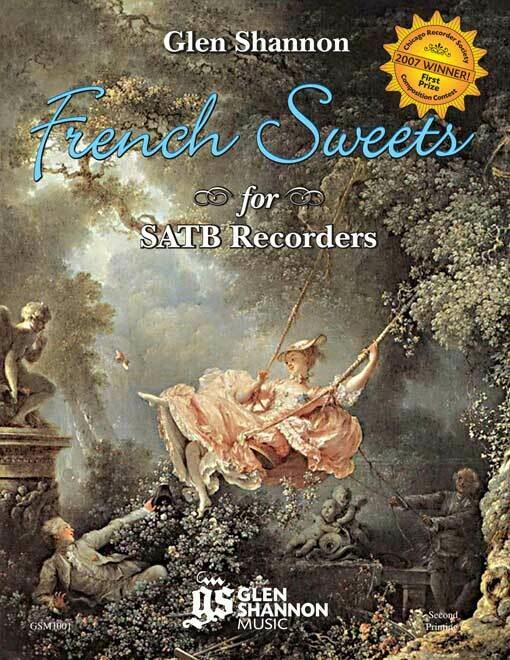
French Sweets
The little “+” symbols over notes indicate those notes as places where a tasteful ornament would be appropriate. Usually this can be a little trill or mordent, either on the note above or below, depending on how you arrived at the ornamented note. There are compendia of instructions for the realization of French Baroque ornaments and a quick perusal of any one of them will provide a wealth of information on how to ornament French Sweets.
Overture: This movement follows standard French Overture structure: A light fugal section is flanked by pompous, over-dotted, slow moving pageantry. The dramatic beginning, driven by the bass, includes descending scales shared by two parts, such as in measures 1, 2 and 7, which should sound like a single line as on a keyboard instrument. This gives way to a poignant, intimate moment at measure 9, with a statement in the Soprano answered sweetly by the Tenor. The Dramatiquement at measure 14 conjures up imagery of a long journey across the windswept plains, overcoming hardship, etc. Slight notes inégales (light swing) should be employed in the slow sections that frame the fugue. The
contrast in mood between the heavy outer portions and the light inner fugue should be exaggerated.
Allemande: Opening with the Tenor line featured, the Allemande should be played with croches (8th-notes) inégales throughout. When the Tenor finishes the melody at measure 8, there is a new period of mystery, in a minor key. The movement’s second half is just like the first, except part of the melody is inverted and given to the Alto.
Courante: The triple-meter movement often has two pulses in one part against three in another. Do not over-dot; the pickup notes are right in tempo. It is fun to play the three half-notes of measure 12 in a slimy manner.
Bourrées: Croches inégales both halves of this movement a nice swing; the slurred pairs of Bourrée II do not cancel out the inégales. Bourrée II’s surprise key signature of A Major may be uncustomary to recorder players but will be worth the effort for the contrasting brightness with respect to Bourrée I. The “§” symbols in the Soprano part of Bourrée I and Bass part of Bourrée II help the eye find its place on the repeat, because the section begins in the middle of the system.
Gigue: Watch for the hemiolas which earn it the name “L’espagnole”; rather than 123-456 the 8th-notes must be grouped 12-34-56, which is further indicated by the paired beaming and accompanying quarter-notes.

Local Dealers to You
You don't have to get it from me! If you are in any of these areas, you can find my music in your favorite store. For international orders, Peacock Press in the UK also publishes my work, which could save on shipping.
US:
Courtly Music Unlimited, Warrensburg, NY
Honeysuckle Music, St. Paul, MN
Performers Music, Chicago, IL
The Recorder Shop, Hannacroix, NY
Unicorn Music, Bloomington, IN
Von Huene Workshop, Brookline, MA
UK:
Recorder Music Mail/Peacock Press
Germany:
Asia:
Recorder Music Garden, Taiwan
Sasaya Music, Japan
Australia:
Shipping Info
Shipping options within the US are available at checkout. For international orders, USPS First Class is the default shipping method unless otherwise selected.

